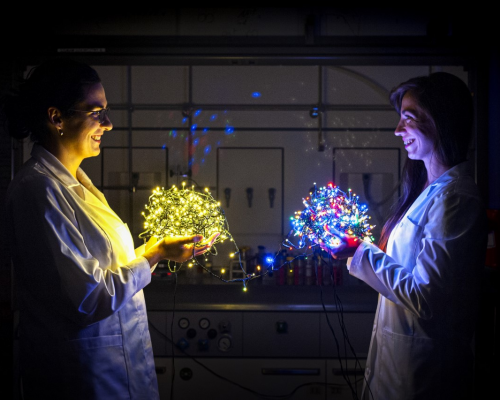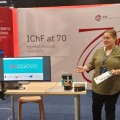Shocking paint – let’s get cell in
Reading time: about 6 minuts

Delivering the biologically active molecules in the cells is one of the most common ways to test the interactions of the particular compounds like drugs with the cells. The biological membranes have a complex structure, so their crossing is not plain sailing, and only some molecules can get inside the cell. Recently, researchers from the Institute of Physical Chemistry, Polish Academy of Sciences, have demonstrated novel polymer-based solutions acting as an osmotic shock agent that facilitates the entering the cell to deliver certain chemicals.
The cells mean life. They are the body's fundamental building blocks. Cells comprise tissues that depending on the type, have different functions to make organs work together in the complex system. The body has trillions of cells, many of which contain the nucleus as a holy grail of life, hiding genetic information. Cells are also responsible for energy production, respiration, and many other biochemical processes, so they have a natural self-protecting shield screening them from the outer environment that could disturb functioning. Cells are coated with the double membrane having a unique and complex structure full of tiny channels allowing only small molecules, ions, and water to get in.
Thanks to the membrane, the cell's interior is protected against chemical reactions that undergo elsewhere. Imagine what would happen if the molecules freely entered the cell through the pores. It would surely lead to disturbance of the proper functioning from the energy production to the transcription of the genes and, finally, to cell damage. In contrast, if the pores were too tight to the double membrane or there would be no pores, there would be no exchange of crucial chemicals and…no life.. So, the "golden mean" is needed, and each biological membrane shielding the cell has its self-regulation system controlling the molecules' transfer.
As it effectively exchanges only specific molecules, how would it work in the case of the in vitro studies, where for example, the macromolecules like proteins acting as drugs for some diseases need to be delivered to the cell for tests? Well, it depends on the cell area. As the loading of small molecules would not be a problem, the large molecules delivery can be challenging. What would we like to put in the cell, some dye working as a marker that enables precise microscopic observations of some chemical processes? It is also not as easy as it sounds. Crossing the cell membrane is critical in most biochemical processes and biomedical studies, while the structure and composition of the biological membranes is a natural mechanism regulating processes and simply protecting the cell from disaster. It works for the membrane enveloping the whole cell. Therefore, much effort was taken globally to deal with this issue towards the delivery of biologically active molecules like therapeutic agents. Current methods have many limitations, like scaling up and time consumption for commonly known microinjection.
However, the impossible is no more impossible. All for the recent, novel research of researchers from the Institute of Physical Chemistry, Polish Academy of Sciences, led by prof. Robert Hołyst. Their work makes passing large molecules in the cell easier than ever before.
They have investigated a range of colloidal solutions having different compositions and concentrations of polymers sized from 1 to 15 nm loading them into the cells. Scientists examined the behavior of the cell interior under osmotic stress when it was exposed to particular solutions. Then, the viscosity studies of the cytoplasm were analyzed, presenting that the standard procedures currently available, like the use of sucrose in the delivery process, are no longer needed to induce the osmotic pressure to load particular molecules. In other words, they presented the effectiveness of hypertonic solutions focusing on the delivery effectiveness at a single-cell level. So far, the optimal biocompatible polymer-based solution can be used to reach the interior of the cell without microinjections or sucrose.
To visualize the effect of the delivery of the polymer-based solution, they have used Fluorescence Correlation Spectroscopy (FCS) along with the confocal microscopy technique to support intracellular concentration measurements or particular chemicals and provide non-invasive delivery effectiveness. They delivered solutions that worked simply as some paint marking the cell under the FCS.
They found the sequence of processes occurring during the exposure of the cell to the hypertonic solution. As the water flows out of the cell, equalizing the osmotic pressure, the cytoplasm solution becomes hypotonic. Such an osmotic pressure difference leads to the relaxation of the double membrane that is crucial to deliver other molecules in the cell. If the osmotic pressure is high enough, the delivery of particular compounds is possible.
“We found that cellular delivery effectiveness strongly correlates with the size and concentration of osmotic pressure building polymers and not with the high value of the osmotic pressure itself. We show that polymer solutions at the entangled regime of concentrations enhance the delivery of large biomacromolecules even of size 200 nm (DNA plasmids) into cells, including MDA-MB-231 cells – so far resistant to the osmotic procedure. We show that the colloid loading medium based on entangled polymer chains is a versatile cargo delivery tool for molecular biology.” – remarks the first author of the research – dr. Aneta Karpińska.
Optimizing the composition of the polymer-based solution and the size of particular molecules, researchers from IPC PAS demonstrated the universal agent that can be used as an intracellular marker and facilitate the loading of other molecules. It contains polymers spheres that work together to induce the osmotic shock mediating cellular delivery. In other words, the solution works just like a brush painting particular molecules that can be seen under confocal microscopy, making it easier to observe the cell's loading with molecules.
Dr. Karina Kwapiszewska claims “We show that a clear understanding of the physical parameters of the delivery solution is strictly connected with the biological outcome. We state that physical insight into biology-related reagents should be a starting point in their development and improvement. We also proved that osmotic shock is a less cell-invasive way for polymers delivery than the method based on liposomes formation.”
Moreover, the research demonstrated by the interdisciplinary team from the IPC PAS was so promising that researchers have decided to commercialize their ideas and bring them to life. The new product was created thanks to their work on the composition of the colloidal solution, boosting cellular delivery efficiency through the osmotic shock.
They offer the novel Cell-IN non-invasive and effective loading reagent that ensures effective cellular uptake of different compounds, from small proteins to nucleic acids, polymers, and nanoparticles, into mammalian cells. Using the Cell-IN allows it to load many molecules into the interior of the cell and microscopically monitor their mobility. The team is open to collaboration and currently works in the field, preparing more new solutions.
This research was supported by the National Centre for Research and Development, Poland, grant number [LIDER/10/0033/L-9/17/NCBR/2018].
SCIENTIFIC PAPERS:
“Entanglement of polymer chains in hypertonic medium enhances the delivery of DNA and other biomacromolecules into cells”
Aneta Karpińska, Alicja Zgorzelska, Karina Kwapiszewska, Robert Hołyst,
Journal of Colloid and Interface Science, 627, 2022, 270-282, 0021-9797
DOI: https://doi.org/10.1016/j.jcis.2022.07.040.
- Author: Dr Magdalena Osial
- Contact: magdalena@osial.eu
- Photo source: Grzegorz Krzyzewski
- Date: 21.09.2022








